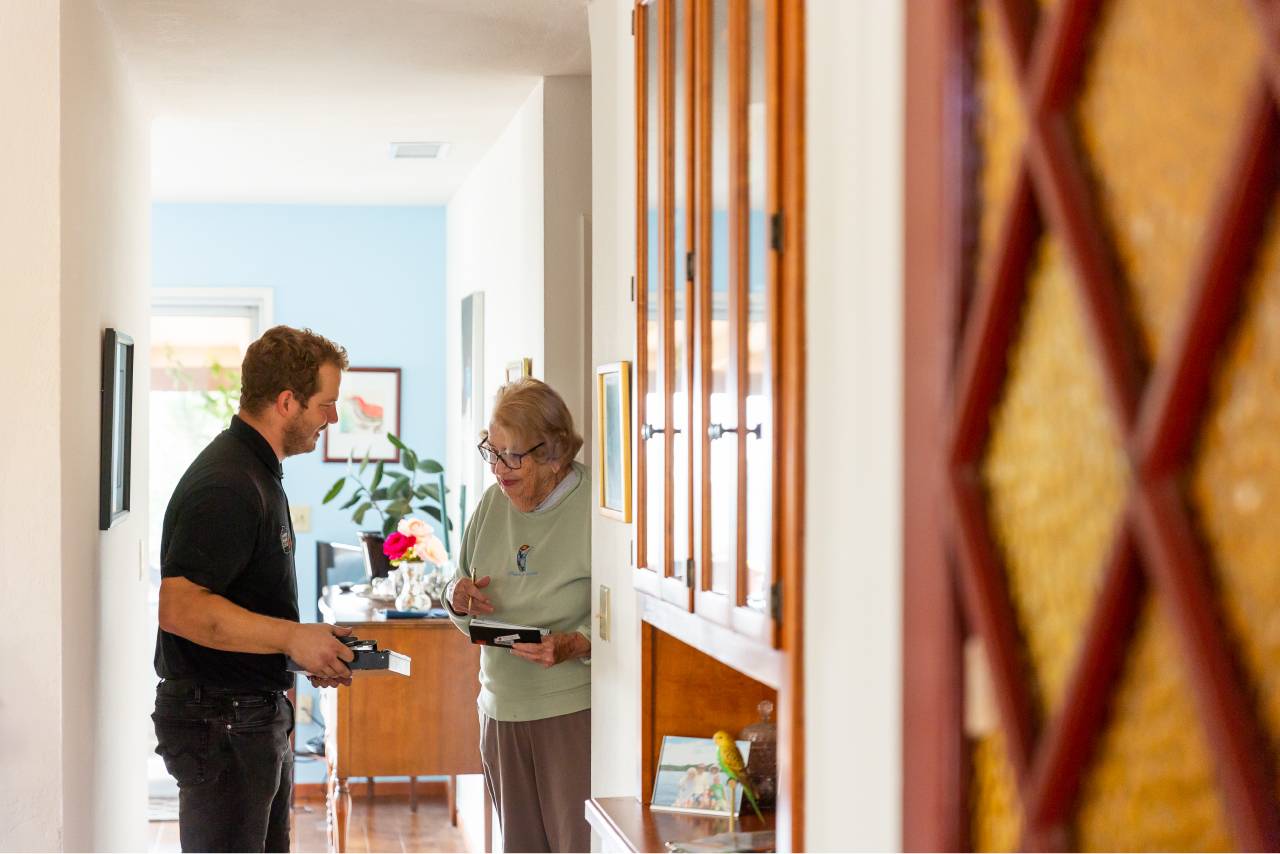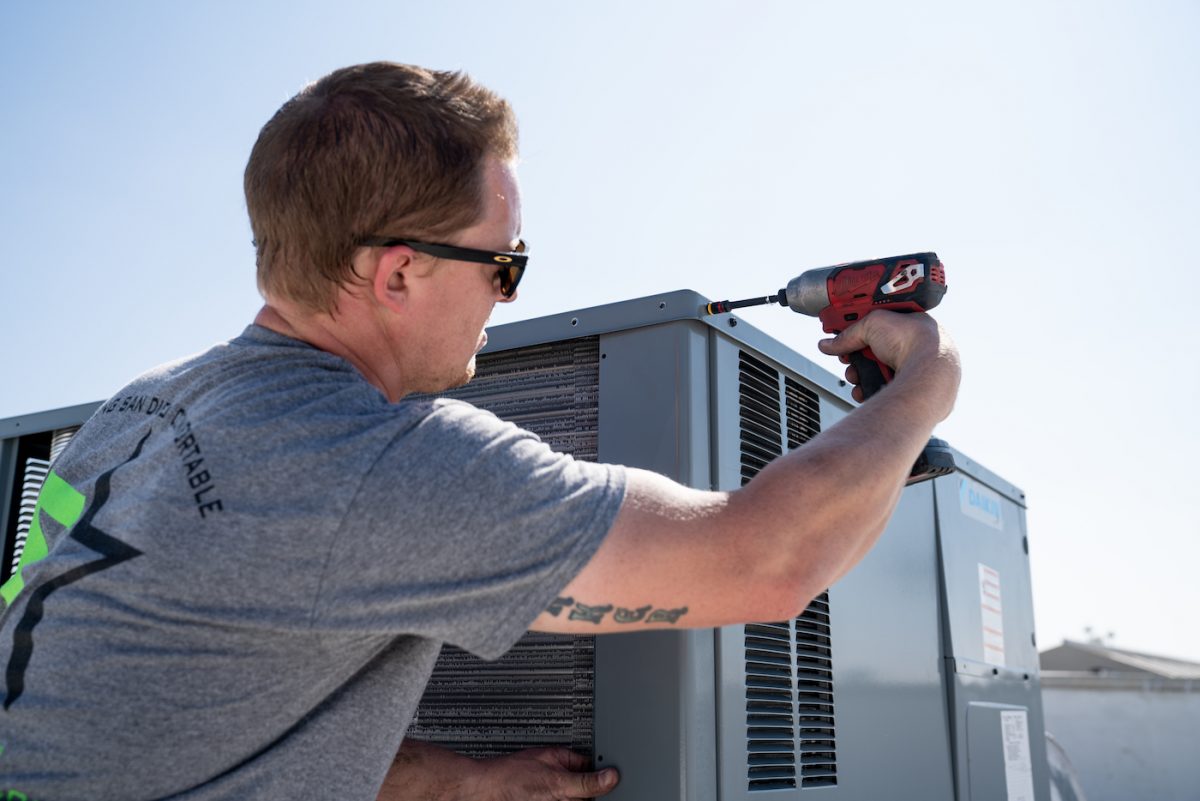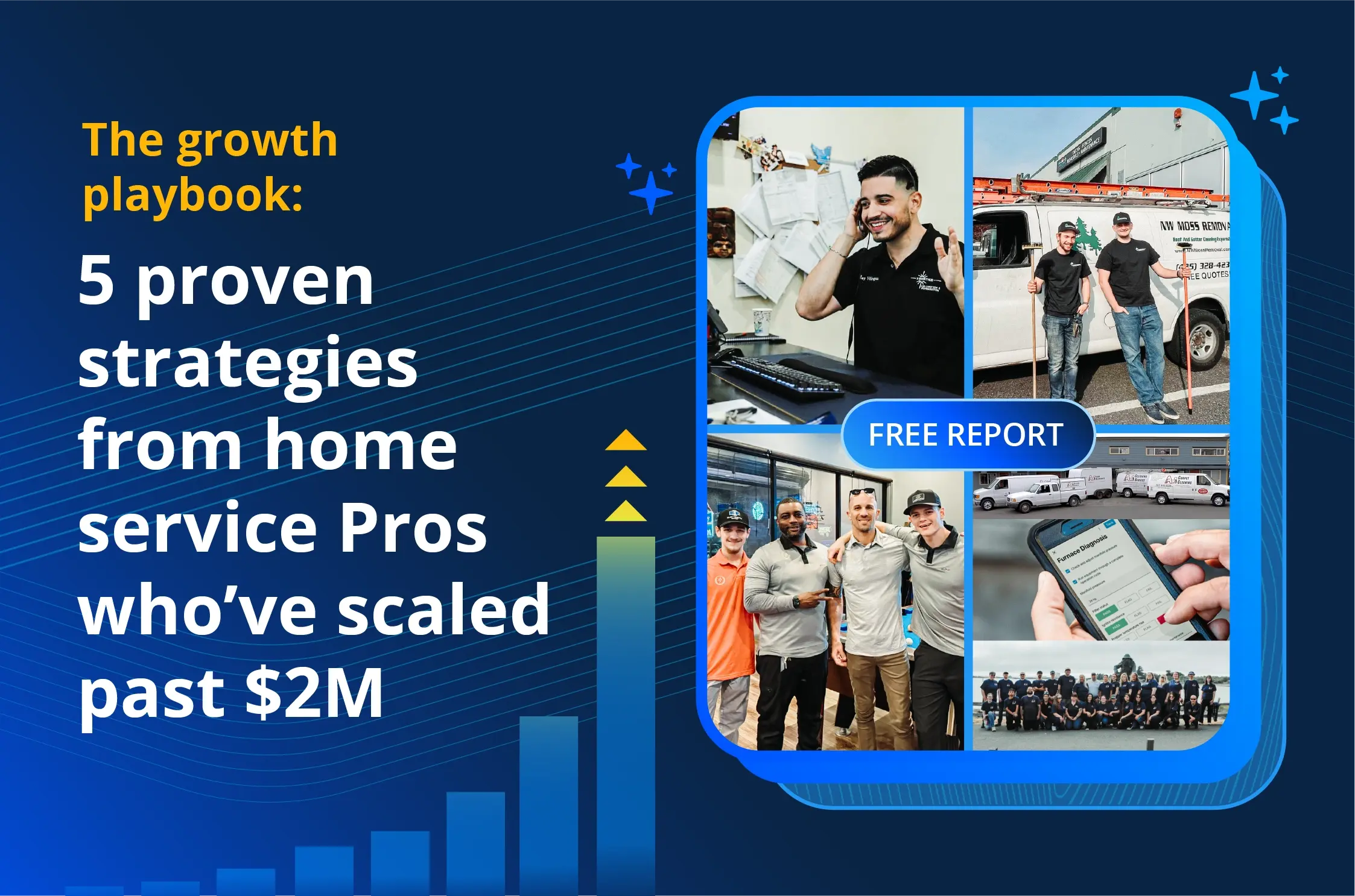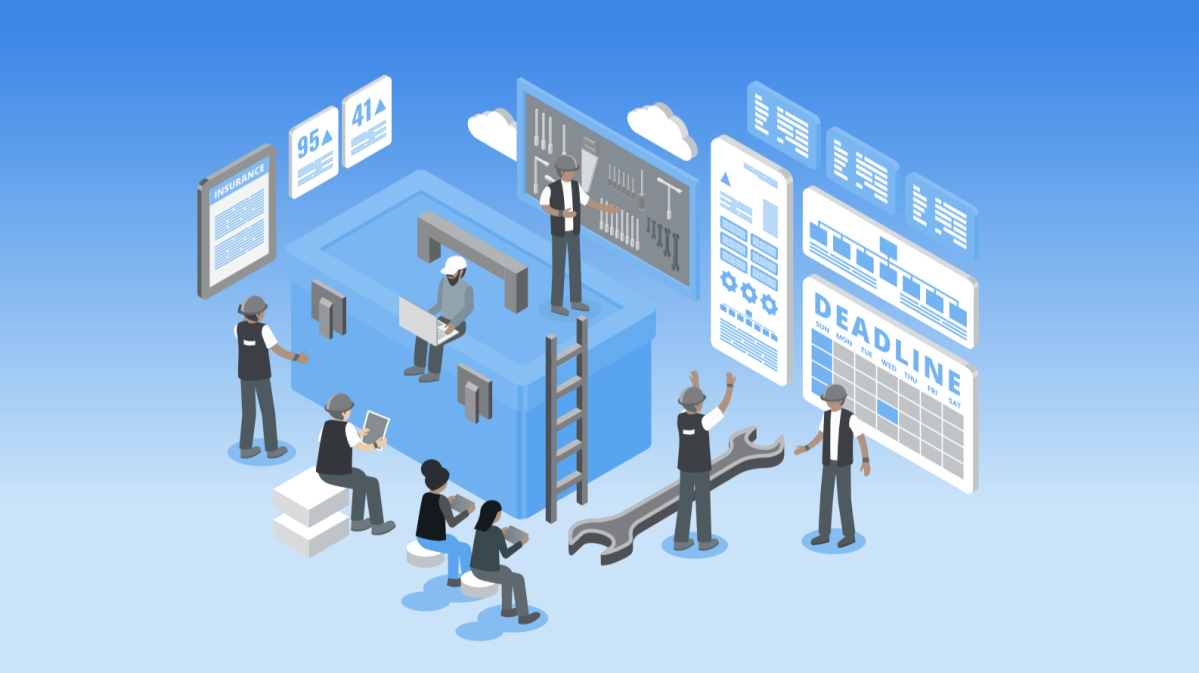Want to win more jobs with less effort?
Grow your business and send quick quotes with our home service software.

Booking new appointments is good. Earning a recurring, more reliable income is better. Have you thought about setting up service agreements for your home services business?
Some industries, like carpet cleaning, home cleaning, and pest control, are a natural fit for recurring agreements. If a client loves your services, get them to agree to a monthly visit while they’re happily gazing over their newly sparkling abode.
For other industries, like plumbing, HVAC or electrical, recurring service agreements look a little different. Sometimes these agreements operate more like an extended warranty or a price discount.
Recurring service plans: what you need to know
For any residential or small commercial service business, there is a way to monetize service agreements that help your bottom line and add real value to the customer. Let’s look at how to frame your approach and some service level agreement examples, including pricing.
Create an effective recurring service agreement
How do you go about creating a plan? Here are the first two steps:
1. Brainstorm the type of work a comprehensive plan would include
The first step is to come up with a list of tasks or types of preventive maintenance activities your plan could possibly include. You can then narrow down that list to the most important actions, keeping in mind the number of things your techs can realistically complete in each visit.
2. Write out an ideal schedule and maintenance checklist.
What keeps your customers’ equipment or property in the best possible shape? Would the maintenance scheduling require monthly or quarterly visits? When you come up with a plan you believe is best for your customers, it’ll be easier to talk to them about it with genuine care.
For the technical trades, for instance, an ideal preventive maintenance schedule would keep piece of equipment running with no unscheduled downtime. Some of this might depend on the age of equipment or their house. You might need several options or modifiers for your plans to meet the needs of all of your customers.
Once you have what might be considered a gold-star plan, you can create other tiers of service that might be more cost-effective. We’ve found that companies that offer different options for plans tend to be more successful at selling them. Our research has found that 87% of homeowners prefer to have choices when presented with a job estimate and service agreements are no different.
Note: If you’re still working in Microsoft Excel to build out your tech’s to-do lists, try out our checklist functionality that you can assign to any job and even attach to a customer invoice. Sign up for a free two-week trial of Housecall Pro to try this out for yourself.
Promote your preventative maintenance plans
Once you have a service agreement or preventive maintenance plan in place, the next step is to educate your customers about it.
- Train your customer service reps, maintenance technicians, and other team members on when and how to bring it up with customers.
- Include a detailed list of what your plan includes on your website.
- Promote the pm plan in an email to your current customers.
- Include a link in any email you send, such as appointment reminders or invoices, for folks to learn more about your plan.
These are just some of the ways you can promote your plan. Next up are tips on how to position it for your customers.
Selling plans to customers
Coming up with a hard sell for your service agreement can be the most challenging part of getting a program off the ground. Customers are leery about being nickelled and dimed, and some of them fear that warranties are just a rip-off.
So, how do you convince a suspicious customer that your recurring service agreement is really worth it? It’s all in how you position the benefits. Here are some guidelines for selling a recurring service agreement to new and current customers:
Frame Your Maintenance Program as Savings
Customers understand why service agreements are good for you, but they need to see why they’re good for them. Will they really get any value?
Emphasize the money saved by catching and fixing problems early, before they have the chance to develop into a larger money pit (like filling a small cavity before you need a root canal). Predictive maintenance is far cheaper than corrective maintenance.
Position your recurring service agreement in terms of quantifiable value. Does your agreement include 10% off all replacement parts? Every receipt should show what the maintenance cost would have been for service agreement members.
Itemize the Benefits.
Your customers like to know exactly what they’re getting. Don’t just offer a vague service agreement without itemizing the details. Maybe your annual service plan includes: 1) 15% off parts 2) Bi-annual visits 3) New air filters 4) Cleaning of the evaporator coil… and, well, you get the idea.
Be sure to clearly define your maintenance schedule and the pm tasks you’ll perform in these visits.
Putting the benefits into not only quantifiable savings but also an easy-to-understand plan checklist makes the value more clear and your sale a whole lot easier.
Don’t Underestimate the Value of Professionalism.
When we talked to our Housecall Pro customers about selling service agreements, many business owners talked about how professionalism makes it easier. One thing that came up again and again: even if you have a higher bid, you can win the job with good communication and an honest manner.
Some of the professional actions our pros take include: itemizing all costs in your bid (including the service agreement fees) and being upfront about the preventive maintenance scheduling. And always follow through.
When your seasonal visit leads to additional work, you’ll also want to itemize all costs in your work orders. Overall, the key here is transparency about all of the work and related costs.
Pricing and Billing
What do pricing and billing look like for a recurring service agreement? For some industries, a recurring payment makes sense, particularly when your visits are monthly. However, for a lot of home services, like plumbing and HVAC, a monthly service plan isn’t a good fit. If you’re not providing a regular monthly service, customers may be tempted to cancel after a few months.
Here are a few tips for successfully pricing and billing a recurring service agreement or warranty plan:
Create Thoughtful Pricing
Your service agreement pricing should always be at a discount. You’re losing a bit of revenue in the short-term, but guaranteeing multiple visits brings in more reliable income in the long-term. Your pricing could be as simple as 10-15% off the regular price. You could also offer steeper discounts at higher service levels (10% off for a 2-visit annual plan, and 15% off for a 4-visit annual plan). If you find that it’s still hard to win people over, consider throwing in a free service or product to sweeten the deal.
Bill Annually
For seasonal plans, an annual payment, often due on the day of the first service visit, is the most streamlined way to bill your customers. You know you’re paid in full from the start, and customers immediately receive a benefit. Everybody’s happy.
When you bill customers the next year, remind customers of their planned maintenance schedule and what they can expect from each visit. Try to schedule their first annual visit as soon as possible to remind them of their benefits.
Make Payment Easy
Offer online payments that your customers can trust. Customers who don’t have to remember to send in a check are more likely to stay current (plus, many younger customers won’t even have a checkbook). Set up automatic payments for your customers and send them receipts.
Recurring Service Agreements by Industry
The guidelines above are a good place to start: Offer a discount; describe benefits in detail; make payment easy. But service agreements still operate differently under various circumstances, as we alluded to earlier.
Here are some service level agreement examples (and food for thought) for some common home services industries. (*Pricing may differ based on the location of service).
Carpet Cleaning
Typical Price Range: $120-$500 for bi-annual residential single- to multiple-room cleaning.
For carpet cleaning, two to three visits a year is often the recommended schedule. How can you convince customers to join a special program? There are a few ways to break down your service agreement options.
1. Have a VIP program and give a steep discount on additional services. Offer customers 25% off your additional services (mopping, spot cleaning, furniture upholstery cleaning) if they sign up.
2. Offer service agreement tiers for small to large homes with increasing price points. Maybe everyone gets two visits per year, but Bronze members can get two rooms cleaned, and Platinum members can get up to 5 rooms cleaned at each visit.
Sell customers on how much they can save by taking care of their carpets instead of replacing them.
Home Cleaning
Typical Price Range: $135-$270 for bi-annual residential visits
Homeowners that are looking into cleaning services don’t usually need to be sold on the importance of regular cleaning. It’s more important to sell them on how much they can save by signing up for a recurring plan.
A home cleaning business is an excellent candidate for incremental service tiers with increased pricing at each level. One possible breakdown would look something like this:
1. Regular Cleaning Plan. 2 visits per year. Dusting, vacuuming, tile and hardwood floor cleaning.
2. Upgraded Cleaning Plan. 2 visits per year. Regular plan plus toilet cleaning, shower cleaning, sink scrubbing, garbage removal.
3. The Busy Bee Cleaning Plan. 12 visits per year. Upgraded cleaning plan plus floor sideboard cleaning and rug cleaning.
4. Pet Lover Cleaning Plan. 12 visits per year. Busy Bee Cleaning Plan plus poop scooping and pet stain removal spot cleaning on floors and furniture.
Pest Control
Typical Price Range: $300-$800 for four annual visits, depending on the lot size.
Pest control is a unique industry in that the acreage of your customer’s property plays a major factor. When you’re nailing down your pest control service agreement, here are some options:
1. Basic Service Plan (¼ acre). 4 visits per year. Spray yard for common invaders. (You can replicate this type of plan for ½ acre, 1 acre, etc. with increased pricing for larger lots).
2. Integrated Service Plan (¼ acre). 4 visits per year. Integrated strategies for a broader array of invaders, including both insects and rodents. (You can also replicate this type of plan into tiers based on acreage).
Window Cleaning or Power Washing
Typical Price Range: $250-$800 for 6-12 visits per year
A window cleaning or power washing business is another great candidate for service agreements based on regular visits with reliable tasks. Windows, home exteriors, and gutters will always get dirty. Still, you can differentiate your service agreements from competitors and create a tier system that works for your company. Here are a few ideas:
1. General Annual Window or Home Exterior Cleaning Services. Once a year cleaning for window exteriors and screens or home exteriors. (You may want to create different prices for ladder work vs. no ladder work).
2. Bi-Annual Window or Home Exterior Cleaning. Twice yearly cleaning for window exteriors and screens or home exteriors.
3. Monthly Window Cleaning. 12 visits per year. Window exteriors, interiors, and screens.
4. Two-Story Window Cleaning. 6 visits per year. Upper and lower window exteriors and screens.
Add more value to any of the plans by including services such as gutter cleaning, roof washing, window frame cleaning, etc.
Plumbing
Typical Price Range: $200-$500 for annual services
Plumbing is an industry where service plans tend to operate more as warranties, which can have a bad reputation as a waste of money. It’s particularly important to outline what is regular routine maintenance or preventive maintenance entails and the typical savings customers see when they schedule consistent maintenance work. Here’s an example of what a preventive plumbing maintenance checklist form looks like.
Tiers for ongoing plumbing service agreements might look like:
1. Silver Service Plan: 2 visits per year. Priority scheduling. Specific maintenance tasks might include inspecting and clearing of all visible drains, inspecting all visible plumbing lines for leaks or breaks, inspecting, and testing the hot water heater. Also include an inspection of any issues that the customer wants to address.
2. Gold Service Plan: 2 visits per year. Priority scheduling and no after-hours fees. Silver plan services plus inspection of all toilet tanks and showerheads, inspection and testing of shut-off valves, and 10% off all repairs.
3. Diamond Service Plan: 2 visits per year. Priority scheduling, no after-hours fees, and no dispatch fees. Gold service plan plus flushing of water heater, and an inspection of all fixtures for leaks and corrosion, and 20% off on all repairs.
Download a free plumbing service plan template now.
HVAC
Typical Price Range: $180-$550 for bi-annual visits, depending on the number of systems
Most homes have an HVAC system that doesn’t get addressed until the A/C suddenly shuts off or the heat goes wonky. Yet, you can successfully set up HVAC preventative maintenance plans that make sense to your customers. You can break up the agreements based on combinations of the following factors:
1. Number and types of systems. Customers will only choose one system, such as radiant heat, may choose a lower price-point than customers who have multiple systems. And different types of equipment will have specific maintenance requirements to consider when you build out these maintenance plans for your customers.
2. Number of visits. Some customers are OK with an annual visit, while homeowners in an older property will have greater peace of mind with multiple visits to check for leaks, corrosion, and other red flags. Give them a breakdown of all the preventive maintenance tasks you’ll be performing.
3. Level of Discount for Repairs. Customers at a Bronze level may earn a 10% off all non-warranty repairs, while Diamond customers get 25% off.
Download a free HVAC service plan template now.
Watch this video to learn how an HVAC business uses Housecall Pro’s recurring service plan feature to generate recurring revenue:
Electrical Work
Typical Price Range: $100-$200 annually for two visits
Electrical work is another area where customers don’t even think to have a service agreement in place because they just figure they’ll call you when they need you. But for a few hundred dollars a year, they can have the peace-of-mind that their systems are up to par. With electrical service agreements, a focus on safety is key. You can also get creative with other niche services. Consider the following:
1. Annual Visits/Safety Check-Ups. A basic service plan will include annual or bi-annual visits to check fuse boxes, main panels, and sub-panels. It could also include small tasks such as replacing the batteries of smoke detectors, checking the fire extinguishers, etc.
2. Generator Maintenance. Customers (often commercial) who have back-up generators may also want a bi-annual visit to inspect their power supply.
3. Holiday Light Hanging. Have you thought about offering a holiday light service? This easy offering saves customers tons of time and won’t require you to use much equipment if any at all.
Download a free electrical service plan template now.
Garage Door Maintenance
Typical Price Range: $80-$150 annually for two visits/cleanings
If you’re in the garage door business, you should also sell your service plans as a form of warranty. By paying for regular visits, your customers can often avoid larger repairs later on. Here are a few ideas for service tiers and offerings:
1. Basic Annual Maintenance Check. 2 visits per year. Cleaning of the door track to remove oil and dirt. Check-up of locking mechanisms, steel rollers, and torsion springs and tubes. Lightweight oil used as needed.
2. Upgraded Annual Maintenance Check. 2 visits per year. Full diagnostic of the entire door. Cleaning the entire door and the door track. Lubrication of all rollers and hinges. 15% off all repairs.






